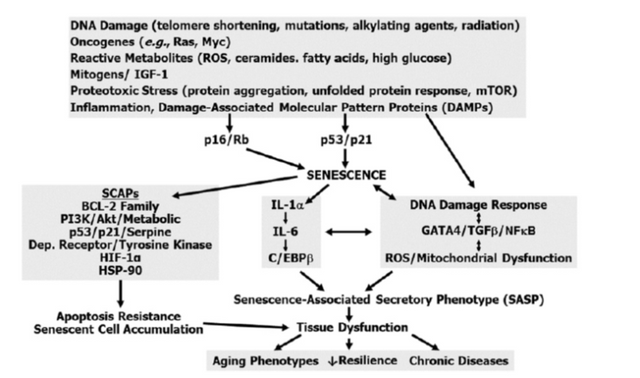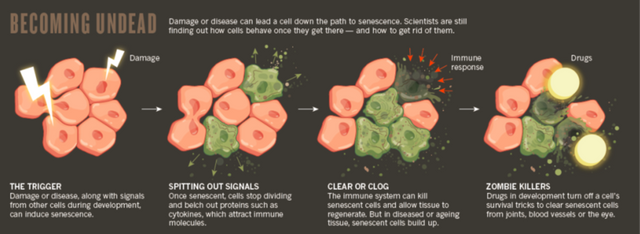Becoming undead - How zombie cells make you older
In the scientific world several discoveries happened by accident for example in 1945 Percy Spencer was messing around with the energy sources of his radar equipment when he noticed that a chocolate bar he had in his pants was melting (not very smart of him to keep a chocolate bar in his pants). Anyway, this accident lead to the invention of the microwave.
There were even more fortuitous episodes, one accident won the Nobel Prize for Elie Metchnikoff. He was observing a starfish under a microscope (you can tell they did not have television at the time), but at lunch time he left the starfish unattended. This was a great opportunity for his kids to mess around with it and poke thorns into it (kids can be mean). When Metchnikoff came back it looked like the show was pretty much over but luckily, he decided to look at the starfish for a last time and he noticed that the cells of the starfish were concentrated around the thorns. Later, he found out that these cells were leukocytes and that gathered around the foreign body (the thorns) to devour the foreign particles. Metchnikoff described this phenomenon as phagocytosis, a major defense mechanism of our body. For this, he was considered the father of immunology and in 1908 he received the Nobel Prize.

Today I want to talk about another fortuitous discovery made by Jan van Deursen, even if he wasn’t poking a starfish with thorns. Van Deursen and his colleagues at the Mayo clinic in Minnesota, were creating transgenic mice, engineered to develop tumors more easily so to test different cures for cancer research. But, instead of developing cancer, his mice were just looking awful, they had thin fur and cataract in their eyes, they were pretty much ageing awfully fast. After some experiments they realized that this was due to the presence of strange cells that would not divide but that would not die, we could say they created mice with zombie cells (Baker et al., 2008). In science we use a less picturesque name for these type of cells, we simply call them senescent cells.
What are senescent cells and why do they form?
First of all let’s say that the concept of senescent cells is not new, Leonard Hayflick coined this term in 1961 where he suggested that there could be ageing at the cellular level (Hayflick & Moorhead, 1961). At the time, little research was conducted on ageing and he was ridiculed and called an idiot by his colleagues for making this observation. Today we know he was onto something, during their life, cells accumulate damage. If the damage is at the DNA level, a cell could pass along the damage to its progeny and this could be a disaster for our body. For this reason, cells have developed defense mechanisms to prevent damaged cells to create other cells bearing the same damage. The options are two: a cell either dies or becomes senescent, which means it stops dividing (Kirkland & Tchkonia, 2017). For years we thought senescent cells were not very important, since they don’t divide why bother studying them (Scudellari, 2017)?
Today we know there is much more into it, there is also a “dark side” to senescence. In 2008, a bunch of studies revealed that senescent cells don’t just stay quiet as we previously thought, but actually produce pro-inflammatory cytokines, growth factors and proteases which combined, cause inflammation in the nearby tissues (Acosta et al., 2008; Coppé et al., 2008; Kuilman et al., 2008). This activity is also known as “senescence associated secretory phenotype (SASP) (Coppé et al., 2008).

Schematic depicting pathways associated with senescence - adapted from (Kirkland & Tchkonia, 2017)
When a tissue is young and healthy, actually a few senescent cells secreting SASP could even stimulate tissue repair and instruct the immune system to get rid of the zombie cells (Scudellari, 2017). However, with ageing and the accumulation of a number of senescent cells we can start observing the insurgence of chronic inflammation that could lead to pathologies such as osteoarthritis (inflammation of the joints) or atherosclerosis (hardening of the arteries). Moreover, these zombie cells show a tissue dependent behavior, depending on their tissue of origin they will secrete different SASP and trigger different responses, this makes it difficult to counteract their action with a universal cure.

OK, so zombie cells cause chronic inflammation, is that all?
Not exactly, we did not finish our story yet. So van Deursen found that the presence of these zombie cells was accelerating ageing in mice (Baker et al., 2008). In 2011 the same team tried to get rid of these zombie cells to see what would happen, they found that these zombie cells accumulate in ageing organs and by eliminating them it is possible to alleviate and even prevent the insurgency of some illnesses (Baker et al., 2011). After these surprising findings, more studies followed and they all showed similar results, by eliminating zombie cells it was possible to restore mice fitness, fur thickness and kidney function(Baar et al., 2017). Also the symptoms of lung diseases could be alleviated (Schafer et al., 2017) and partially restore damaged cartilage (Jeon et al., 2017). A study conducted in 2016 even found that the lifespan of mice could be extended 25% by eliminating senescent cells (Baker et al., 2016).
Following these discoveries a new class of drugs is being developed called senolytics, which means these are molecules that aim at destroying senescent (zombie) cells. However, because the Food and Drug Administration has not labelled ageing as a condition in need of treatment, it is still challenging to obtain funding to conduct research on senescent cells.

Diagram depicting how zombie cells create inflammation and how they can be dealth with - adapted from (Scudellari, 2017)
What would it take to kill senescent cells?
To recap, senescent cells are cells in their twilight, they are not dead yet, but they are not so easy to kill neither. In fact, they rely on several (probably around six) signaling pathways to defy death (Fuhrmann-Stroissnigg et al., 2017; Zhu et al., 2015). Theoretically, a drug to be considered senolytic should disrupt these pathways. So far, 14 different molecules have been described in literature to possess such properties (Chang et al., 2016; Schafer et al., 2017; Yosef et al., 2016; Zhu et al., 2016). Since senescent cells behave differently, probably we won’t find a single drug capable of being effective on all of them, but combination of different senolytics may be a viable option.
There are some advantages in a hypothetical senolytics therapy, for instance we don’t need to eliminate all zombie cells, just killing a few will already show clinical benefits (Scudellari, 2017). Moreover, the therapy would not interfere with the formation of senescent cells, which means that our cells will maintain this tumor suppressing feature and become senescent if they undergo DNA damage. This is crucial as a senolytic therapy will likely have small side effects, also considering that it would be a “hit and run” type of therapy. This means that the patient won’t be under senolytic administration for prolonged periods of time, but just once or twice a year.
Just to be clear, senolytic therapy won’t stop ageing but it may alleviate some of its symptoms. If we really want to stop ageing first we need to understand what ageing really is.
References:
- Acosta, J. C., O’Loghlen, A., Banito, A., Guijarro, M. V, Augert, A., Raguz, S., … Gil, J. (2008). Chemokine signaling via the CXCR2 receptor reinforces senescence. Cell, 133(6), 1006–18. https://doi.org/10.1016/j.cell.2008.03.038
- Baar, M. P., Brandt, R. M. C., Putavet, D. A., Klein, J. D. D., Derks, K. W. J., Bourgeois, B. R. M., … de Keizer, P. L. J. (2017). Targeted Apoptosis of Senescent Cells Restores Tissue Homeostasis in Response to Chemotoxicity and Aging. Cell, 169(1), 132–147.e16. https://doi.org/10.1016/j.cell.2017.02.031
- Baker, D. J., Childs, B. G., Durik, M., Wijers, M. E., Sieben, C. J., Zhong, J., … van Deursen, J. M. (2016). Naturally occurring p16(Ink4a)-positive cells shorten healthy lifespan. Nature, 530(7589), 184–9. https://doi.org/10.1038/nature16932
- Baker, D. J., Perez-Terzic, C., Jin, F., Pitel, K. S., Pitel, K., Niederländer, N. J., … van Deursen, J. M. (2008). Opposing roles for p16Ink4a and p19Arf in senescence and ageing caused by BubR1 insufficiency. Nature Cell Biology, 10(7), 825–36. https://doi.org/10.1038/ncb1744
- Baker, D. J., Wijshake, T., Tchkonia, T., LeBrasseur, N. K., Childs, B. G., van de Sluis, B., … van Deursen, J. M. (2011). Clearance of p16Ink4a-positive senescent cells delays ageing-associated disorders. Nature, 479(7372), 232–6. https://doi.org/10.1038/nature10600
- Chang, J., Wang, Y., Shao, L., Laberge, R.-M., Demaria, M., Campisi, J., … Zhou, D. (2016). Clearance of senescent cells by ABT263 rejuvenates aged hematopoietic stem cells in mice. Nature Medicine, 22(1), 78–83. https://doi.org/10.1038/nm.4010
- Coppé, J.-P., Patil, C. K., Rodier, F., Sun, Y., Muñoz, D. P., Goldstein, J., … Campisi, J. (2008). Senescence-Associated Secretory Phenotypes Reveal Cell-Nonautonomous Functions of Oncogenic RAS and the p53 Tumor Suppressor. PLoS Biology, 6(12), e301. https://doi.org/10.1371/journal.pbio.0060301
- Fuhrmann-Stroissnigg, H., Ling, Y. Y., Zhao, J., McGowan, S. J., Zhu, Y., Brooks, R. W., … Robbins, P. D. (2017). Identification of HSP90 inhibitors as a novel class of senolytics. Nature Communications, 8(1), 422. https://doi.org/10.1038/s41467-017-00314-z
- Hayflick, L., & Moorhead, P. S. (1961). The serial cultivation of human diploid cell strains. Experimental Cell Research, 25(3), 585–621. https://doi.org/10.1016/0014-4827(61)90192-6
- Jeon, O. H., Kim, C., Laberge, R.-M., Demaria, M., Rathod, S., Vasserot, A. P., … Elisseeff, J. H. (2017). Local clearance of senescent cells attenuates the development of post-traumatic osteoarthritis and creates a pro-regenerative environment. Nature Medicine, 23(6), 775–781. https://doi.org/10.1038/nm.4324
- Kirkland, J. L., & Tchkonia, T. (2017). Cellular Senescence: A Translational Perspective. EBioMedicine, 21, 21–28. https://doi.org/10.1016/j.ebiom.2017.04.013
- Kuilman, T., Michaloglou, C., Vredeveld, L. C. W., Douma, S., van Doorn, R., Desmet, C. J., … Peeper, D. S. (2008). Oncogene-induced senescence relayed by an interleukin-dependent inflammatory network. Cell, 133(6), 1019–31. https://doi.org/10.1016/j.cell.2008.03.039
- Schafer, M. J., White, T. A., Iijima, K., Haak, A. J., Ligresti, G., Atkinson, E. J., … LeBrasseur, N. K. (2017). Cellular senescence mediates fibrotic pulmonary disease. Nature Communications, 8, 14532. https://doi.org/10.1038/ncomms14532
- Scudellari, M. (2017). To stay young, kill zombie cells. Nature, 550(7677), 448–450. https://doi.org/10.1038/550448a
- Yosef, R., Pilpel, N., Tokarsky-Amiel, R., Biran, A., Ovadya, Y., Cohen, S., … Krizhanovsky, V. (2016). Directed elimination of senescent cells by inhibition of BCL-W and BCL-XL. Nature Communications, 7, 11190. https://doi.org/10.1038/ncomms11190
- Zhu, Y., Tchkonia, T., Fuhrmann-Stroissnigg, H., Dai, H. M., Ling, Y. Y., Stout, M. B., … Kirkland, J. L. (2016). Identification of a novel senolytic agent, navitoclax, targeting the Bcl-2 family of anti-apoptotic factors. Aging Cell, 15(3), 428–35. https://doi.org/10.1111/acel.12445
- Zhu, Y., Tchkonia, T., Pirtskhalava, T., Gower, A. C., Ding, H., Giorgadze, N., … Kirkland, J. L. (2015). The Achilles’ heel of senescent cells: from transcriptome to senolytic drugs. Aging Cell, 14(4), 644–58. https://doi.org/10.1111/acel.12344
The only natural way of killing senescent cells while preserving healthy ones is to induce AUTOPHAGY
Autophagy is your cells' metabolic pathway for self-digesting old and wasted cells and converting them back into energy. Basically, eating yourself for survival
What induces AUTOPHAGY?
It's still a mystery but the key factor is to suppress mTOR the most anabolic pathway that causes cellular growth.
To induce autophagy, you can do intermittent fasting, deplete your glycogen through carbohydrate restriction, and suppress insulin with the ketogenic diet
Fasting for longer than 48 hours is going to ramp up autophagy that puts you into a semi-catabolic state in which your cells start cleaning out the house. This is also going to preserve your lean muscle mass because after you shift into ketosis, you reduce muscle catabolism to close to zero and start burning exclusively your own body fat for fuel
Other ways to promote autophagy are exercise, sauna, coffee, turmeric, and berberine
Are you thinking about doing this topic as a post? If not, I would like to as @suesa to do one. She does some of the best biology research and work and she is willing to take requests when something looks fun (whoo hoo! directed research!) She is definitely worth looking up if you haven't seen her blog yet.
I actually read the "short-term fasting increases autophagy activity" thing a while ago but decided against writing a post about it, because the research I found wasn't meaningful enough (in my opinion, but maybe I was just too lazy to do deeper research). I mentioned it before tho:
From You're Being Eaten Alive
The corresponding sources:
Autophagy in general
Autophagy and fasting
With your skills I think you could easily make anything look interesting. Also you write posts with an incredible regularity, that's not laziness, maybe the topic did not struck the right chord in you and you simply decided to spend your time writing about something else
Interesting reading this right now, since I started doing this recently. I basically stop eating 4 hours before going to bed, which means 12 hours fasting every day. Easy peasy, and I'm already feeling more energetic and I'm sleeping better (unless of course it's placebo..).
That is an interesting observation, I think it may be worth writing a post about it and link some references to support those claims
I really love reading about all those discoveries that were fortuit. The stories are always cool. Always. :)
I agree, there is so much we can learn from those like for example always keep a chocolate bar in your pants or let your kids play in your office when you need inspiration :) probably there are also smarter things to learn, of that I am sure :)
There's always the 'chase kids away from whatever mess they're making so you can look at it again in depth' lesson and, as Jan van Deursen found out, there's the 'don't get discouraged by noticing the obvious (or not so obvious) when your peers think that it's stupid'. (big sigh!) It never pays to be a researcher ahead of his time.
I did not see you for a while, I am glad you are back, you are my number 1 commentator! :)
Thanks. You're doing better than ever. Excellent content wins out every time!
thank you :)
Great storytelling + incredible content.
You, sir, are AWESOME.
Thank you for sharing.
please keep up this kind of incredible post
Wow, I didn't know senescent cells even existed. This is cool stuff!
Amazing Storytelling I am mesmerized by this i have followed you , upvoted also , please stay in touch , xx
I love zombies, too
Agreed I find them fascinating ,
Thank you, I am glad you liked it :)
Loved it ! :)
Excellent, keep up with this kind of work, it was very interesting for me as a medicine student
Thank you and good luck with your studies!
The Walking Dead is real?
Cells don't exactly walk, maybe we can say "The crawling dead"? :)
Yes, unless if the zombie viruses can control the brain to make it walk or whatever. I'm not sure how zombie viruses and cells would work but crazy stuff happens. There are a lot of things the general public may not be aware of in life. The crawling dead would not make a great show I guess but it may be more accurate.
I would have assumed that those ageing billionaires would have rushed to fund this research, but I guess they are either pessimistic about the research or they just don't care. Still this discovery is a real breakthrough in anti ageing study. It won't stop us from ageing as you say, but I believe we are on the right track. Thanks for the informative article. Have a nice day.
I am glad you liked it, I think there is still so much we don't know about ageing, that is both a bad and a good thing, from the positive side it means there is much we can learn and improve, if you happen to know a couple of old billionaires please tell them to spend some change in funding research! :)
I think that this is where crowd funding comes in - maybe a project won't fly with the government but that doesn't mean that people won't jump at the chance to feel young again? This kind of project might be very popular if someone can prove they are serious about it and that they have the background to make it happen. maybe? You could at least get some newspaper coverage out of this kind of story!
It's actually not so easy to get funding to study senescence. The FDA does not consider ageing as a serious health risk so they prioritize funding of other topics. I know it's weird and it makes little sense especially when you consider that we waste much more money creating weapons to fight invisible (immaginary?) enemies, yet ageing is going to affect all of us for sure. A trend I see in the US is that if you want to get your research to be funded you should find a link to a military use and submit a proposal to the department of defense, that's sad.
Now that's a fact! The cosmetic industry is said to be beginning to see booming business ( I've heard) as a larger portion of the population in the 1st world countries starts to age so there soon may be more interest in more in-depth research. I believe that the greater interest may also have to do with people in 1st world countries living significantly longer and wanting to make the most of the extended time so larger companies my be more willing to put some effort into the research.
It's just a guess of course.
I was thinking the same thing about those aging billionaires. I thought they would be the first to push funding through.
Good read. This is the first time I've heard of this "zombie cells" thanks to you:)